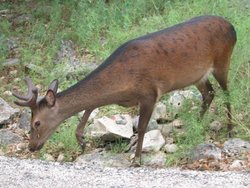Deer
|
|
| Deer | ||||||||||||
|---|---|---|---|---|---|---|---|---|---|---|---|---|
 | ||||||||||||
| Scientific classification | ||||||||||||
| ||||||||||||
| Genera | ||||||||||||
|
About 15 in 4 subfamilies. |
Defined strictly, a deer is a ruminant mammal belonging to the family Cervidae. A number of broadly similar animals, from related families within the order Artiodactyla, are often also called deer.
Depending on the species, male deer are called stags, harts, bucks or bulls, and females are called hinds, does or cows. Young deer are called fawns or calves. Hart is an expression for a stag, particularly a Red Deer stag past its fifth year. It is not commonly used, but an example is in Shakespeare's "Romeo and Juliet" when Tybalt refers to the brawling Montagues and Capulets as hartless hinds. "The White Hart" and "The Red Hart" are common English pub names.
Deer are widely distributed, with representatives in all continents except Australia and Africa. Australia does have six introduced species of deer that have established sustainable wild populations from Acclimatisation Society releases in the 19th Century. These are Fallow Deer, Red Deer, Sambar Deer, Hog Deer, Rusa Deer, and Chital Deer[1] (http://rubens.anu.edu.au/student.projects/rabbits/wildanim.html). Although exotic to the continent, environmental factors restrict their ranges to habitable patches, thereby preventing any one species from becoming a serious pest. Red deer introduced into New Zealand in early 1900s (a gift from United States President Theodore Roosevelt) have been largely domesticated since the late 1960s and are common farm animals there now.
Deer differ from other ruminants in that they have antlers instead of horns. Antlers are bony growths that develop each year (usually in summer) and, in general, it is only male deer that develop them (although there are exceptions).
There are about 43 species of deer worldwide, divided into two broad groups: the old world group includes the subfamilies Muntiacinae and Cervinae; the new world deer the subfamilies Hydropotinae and Capreolinae. Note that the terms indicate the origin of the groups, not their modern distribution: the Water Deer, for example, is a new world species but is found only in China and Korea.
It is thought that the new world group evolved about 5 million years ago in the forests of North America and Siberia, the old world deer in Asia.
Deer are selective feeders. They have small, unspecialised stomachs by herbivore standards, and high nutrition requirements: ingesting sufficient minerals to grow a new pair of antlers every year is a significant task. Rather than attempt to digest vast quantities of low-grade, fibrous food as, for example, sheep and cattle do, deer select easily digestible shoots, young leaves, fresh grasses, soft twigs, fruit, fungi, and lichens.
Deer have long had economic significance to humans. While they are generally not as easily domesticated as sheep, goats, pigs, and even cattle, the association between people and deer is very old. Deer meat, for which they are hunted and farmed, is called venison.
Deer_running.jpg
White-tailed_deer.jpg
Nature_and_Appearance_of_Deer_and_how_they_can_be_hunted_with_Dogs_Fac_simile_of_a_Miniature_in_the_Livre_du_Roy_Modus_Manuscript_of_the_Fourteenth_Century_National_Library_of_Paris.png
SUBORDER RUMINANTIA
- Family Tragulidae: chevrotains
- Family Moschidae: musk deer
- Family Cervidae
- Subfamily Muntiacinae (Muntjac and related)
- Indian Muntjac, Muntiacus muntjak
- Reeves's Muntjac, Muntiacus reevesi
- Hairy-fronted Muntjac, Muntiacus crinifrons
- Fea's Muntjac, Muntiacus feae
- Roosevelt's Muntjac, Muntiacus rooseveltorum
- Gongshan Muntjac, Muntiacus gongshanensis
- Bornean Yellow Muntjac Muntiacus atherodes
- Giant Muntjac, Muntiacus vuquangensis
- Truong Son Muntjac Muntiacus truongsonensis
- Leaf muntjac Muntiacus putaoensis
- Tufted Deer, Elaphodus cephalophus
- Subfamily Cervinae
- Fallow Deer, Dama dama
- Chital, Axis axis
- Hog Deer, Axis porcinus
- Kuhl's Deer, Axis kuhlii
- Calamian Deer, Axis calamianensis
- Thorold's Deer, Cervus albirostris
- Swamp Deer, Cervus duvaucelii
- Red Deer (Wapiti, Elk) Cervus elaphus
- Eld's Deer, Cervus eldii
- Sika Deer, Cervus nippon
- Rusa Deer, Cervus timorensis
- Sambar Deer, Cervus unicolor
- P貥 David's Deer, Elaphurus davidianus
- Irish Elk, Megaloceros giganteus (extinct)
- Subfamily Hydropotinae
- Water Deer, Hydropotes inermis
- Subfamily Capreolinae
- Mule Deer, Odocoileus hermionus
- Black-tailed Deer, Odocoileus hemionus columbianus
- White-tailed Deer, Odocoileus virginianus
- Key Deer Odocoileus virginianus clavium
- Roe Deer, Capreolus capreolus
- Moose (Elk), Alces alces
- Reindeer (Caribou), Rangifer tarandus
- Marsh Deer, Blastocerus dichotomus
- Pampas Deer, Ozotoceros bezoarticus
- Chilean Huemul, Hippocamelus bisulcus
- Peruvian Huemul, Hippocamelus antisensis
- Red Brocket, Mazama americana
- Brown Brocket, Mazama gouazoupira
- Little Red Brocket, Mazama rufina
- Dwarf Brocket, Mazama chunyi
- Southern Pudu, Pudu pudu
- Northern Pudu, Pudu mephistophiles
- Mule Deer, Odocoileus hermionus
- Subfamily Muntiacinae (Muntjac and related)
- Family Giraffidae: Giraffe and Okapi
- Family Antilocapridae: Pronghorn
- Family Bovidae: cattle, goats, sheep, and antelope

